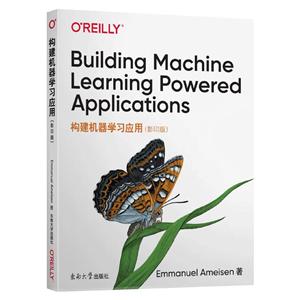包郵 構(gòu)建機器學(xué)習(xí)應(yīng)用(影印版)(英文版)
-
>
全國計算機等級考試最新真考題庫模擬考場及詳解·二級MSOffice高級應(yīng)用
-
>
決戰(zhàn)行測5000題(言語理解與表達)
-
>
軟件性能測試.分析與調(diào)優(yōu)實踐之路
-
>
第一行代碼Android
-
>
JAVA持續(xù)交付
-
>
EXCEL最強教科書(完全版)(全彩印刷)
-
>
深度學(xué)習(xí)
構(gòu)建機器學(xué)習(xí)應(yīng)用(影印版)(英文版) 版權(quán)信息
- ISBN:9787564189518
- 條形碼:9787564189518 ; 978-7-5641-8951-8
- 裝幀:一般膠版紙
- 冊數(shù):暫無
- 重量:暫無
- 所屬分類:>
構(gòu)建機器學(xué)習(xí)應(yīng)用(影印版)(英文版) 本書特色
作者Emmanuel Ameisen是一名經(jīng)驗豐富的數(shù)據(jù)科學(xué)家,他領(lǐng)導(dǎo)著一個人工智能教育項目群,通過代碼片段、插圖和截圖以及對行業(yè)領(lǐng)袖的采訪內(nèi)容展示實用的機器學(xué)習(xí)概念。 本書**部分教授如何設(shè)計一個機器學(xué)習(xí)應(yīng)用程序并評估效果;第二部分介紹如何構(gòu)建一個可用的機器學(xué)習(xí)模型;第三部分演示改進模型的方法,讓模型滿足你*初的設(shè)想;第四部分介紹應(yīng)用部署和監(jiān)測策略。 這本書將幫助你: 定義產(chǎn)品目標,確立一個機器學(xué)習(xí)問題 快速構(gòu)建一個端到端的機器學(xué)習(xí)流水線并獲取一個初始數(shù)據(jù)集 培訓(xùn)和評估機器學(xué)習(xí)模型并解決性能瓶頸 在生產(chǎn)環(huán)境中部署和監(jiān)測模型
構(gòu)建機器學(xué)習(xí)應(yīng)用(影印版)(英文版) 內(nèi)容簡介
學(xué)習(xí)設(shè)計、構(gòu)建和部署機器學(xué)習(xí)(ML)應(yīng)用所需的技能。通過這本實用的教程,你將構(gòu)建一個機器學(xué)習(xí)驅(qū)動的示例應(yīng)用程序,將很初的想法轉(zhuǎn)化成可部署的產(chǎn)品。數(shù)據(jù)科學(xué)家、軟件工程師和產(chǎn)品經(jīng)理一一無論經(jīng)驗豐富的的專家還是剛剛?cè)腴T的新手一一都可以循序漸進地學(xué)習(xí)構(gòu)建實際的機器學(xué)習(xí)應(yīng)用程序所涉及的工具、很好實踐和技術(shù)挑戰(zhàn)。 作者Emmanuel Ameisen是一名經(jīng)驗豐富的數(shù)據(jù)科學(xué)家,他領(lǐng)導(dǎo)著一個人工智能教育項目群,通過代碼片段、插圖和屏幕截圖以及對行業(yè)的采訪內(nèi)容展示實用的機器學(xué)習(xí)概念。本書部分教授如何設(shè)計一個機器學(xué)習(xí)應(yīng)用程序并評估效果;第二部分介紹如何構(gòu)建一個可用的機器學(xué)習(xí)模型;第三部分演示改進模型的方法,讓模型滿足你很初的設(shè)想;第四部分介紹應(yīng)用部署和監(jiān)測策略。 這本書將幫助你: 定義產(chǎn)品目標,確立一個機器學(xué)習(xí)問題; 快速構(gòu)建一個端到端機器學(xué)習(xí)流水線并獲取一個初始數(shù)據(jù)集; 培訓(xùn)和評估機器學(xué)習(xí)模型并解決性能瓶頸; 在生產(chǎn)環(huán)境中部署和監(jiān)測模型。
構(gòu)建機器學(xué)習(xí)應(yīng)用(影印版)(英文版) 目錄
Preface
Part I. Find the Correct ML Approach
1. From Product Goal to ML Framing
Estimate What Is sible
Models
Data
Framing the ML Editor
Trying to Do It All with ML: An End-to-End Framework
The Simplest Approach: Being the Algorithm
Middle Ground: Learning from Our Experience
Monica Rogati: How to Choose and Prioritize ML Projects
Conclusion
2. Createa Plan
Measuring Success
Business Performance
Model Performance
Freshness and Distribution Shift
Speed
Estimate Scope and Challenges
Leverage Domain Expertise
Stand on the Shoulders of Giants
ML Editor Planning
Initial Plan for an Editor
Always Start with a Simple Model
To Make Regular Progress: Start Simple
Start with a Simple Pipeline
Pipeline for the ML Editor
Conclusion
Part II. Build a Working Pipeline
3. Build Your First End-to-End Pipeline
The Simplest Scaffolding
Prototype of an ML Editor
Parse and Clean Data
Tokenizing Text
Generating Features
Test Your Workflow
User Experience
Modeling Results
ML Editor Prototype Evaluation
Model
User Experience
Conclusion
4. Acquire an Initial Dataset
Iterate on Datasets
Do Data Science
Explore Your First Dataset
Be Efficient, Start Small
Insights Versus Products
A Data Quality Rubric
Label to Find Data Trends
Summary Statistics
Explore and Label Efficiently
Be the Algorithm
Data Trends
Let Data Inform Features and Models
Build Features Out of Patterns
ML Editor Features
Robert nro: How Do You Find, Label, and Leverage Data?
Conclusion
Part III. Iterate on Models
5. Train and Evaluate Your Model
The Simplest Appropriate Model
Simple Models
From Patterns to Models
Split Your Dataset
ML Editor Data Split
Judge Performance
Evaluate Your Model: Look Beyond Accuracy
Contrast Data and Predictions
Confusion Matrix
ROC Curve
Calibration Curve
Dimensionality Reduction for Errors
The Top-k Method
Other Models
Evaluate Feature Importancek
Directly from a Classifier
Black-Box Explainers
Conclusion
6. Debug Your ML Problems
Software Best Practices
ML-Specific Best Practices
Debug Wiring: Visualizing and Testing
Start with One Example
Test Your ML Code
Debug Training: Make Your Model Learn
Task Difficulty
Optimization Problems
Debug Generalization: Make Your Model Useful
Data Leakage
Overfitting
Consider the Task at Hand
Conclusion
7. Using Classifiers for Writing Recommendations
Extracting Recommendations from Models
What Can We Achieve Without a Model?
Extracting Global Feature Importance
Using a Model's Score
Extracting Local Feature Importance
Comparing Models
Version 1: The Report Card
Version 2: More Powerful, More Unclear
Version 3: Understandable Recommendations
Generating Editing Recommendations
Conclusion
Part IV. Deploy and Monitor
8. Considerations When Deploying Models
Data Concerns
Data Ownership
Data Bias
Systemic Bias
Modeling Concerns
Feedback Loops
Inclusive Model Performance
Considering Context
Adversaries
Abuse Concerns and Dual-Use
Chris Harland: Shipping Experiments
Conclusion
9. Choose Your Deployment Option
Server-Side Deployment
Streaming Application or API
Batch Predictions
Client-Side Deployment
On Device
Browser Side
Federated Learning: A Hybrid Approach
Conclusion
10. Build Safeguards for Models
Engineer Around Failures
Input and Output Checks
Model Failure Fal
構(gòu)建機器學(xué)習(xí)應(yīng)用(影印版)(英文版) 節(jié)選
“很多關(guān)于機器學(xué)習(xí)的書都跳過了*困難的部分:提煉問題、調(diào)試模型和為客戶部署。但本書關(guān)注的正式這些內(nèi)容,可以讓你的項目從一個想法變成具有影響力的產(chǎn)品。” ——Alexander Gude (Intuit公司的數(shù)據(jù)科學(xué)家)
構(gòu)建機器學(xué)習(xí)應(yīng)用(影印版)(英文版) 作者簡介
Emmanuel Ameisen是Stripe公司的機器學(xué)習(xí)工程師,曾經(jīng)為Local Motion和Zipcar公司實施并部署了預(yù)測分析和機器學(xué)習(xí)解決方案。最近,他正在領(lǐng)導(dǎo)洞見數(shù)據(jù)科學(xué)的人工智能項目群,指導(dǎo)著100多個機器學(xué)習(xí)項目。他擁有法國三所大學(xué)的人工智能、計算機工程和管理碩士學(xué)位。
- >
山海經(jīng)
- >
莉莉和章魚
- >
龍榆生:詞曲概論/大家小書
- >
煙與鏡
- >
大紅狗在馬戲團-大紅狗克里弗-助人
- >
隨園食單
- >
我從未如此眷戀人間
- >
二體千字文















